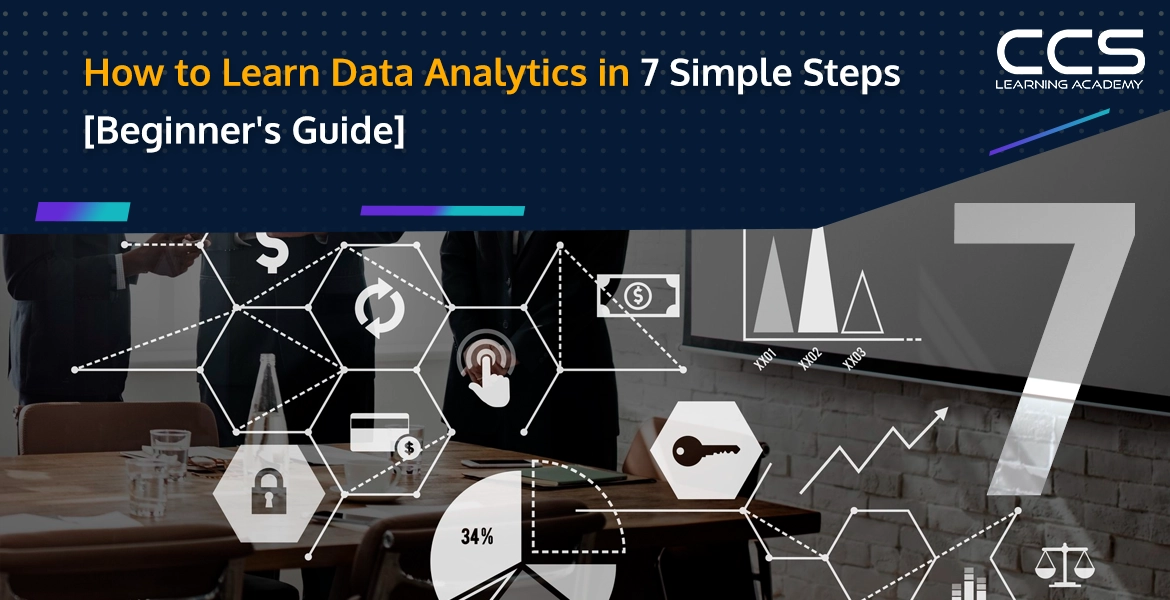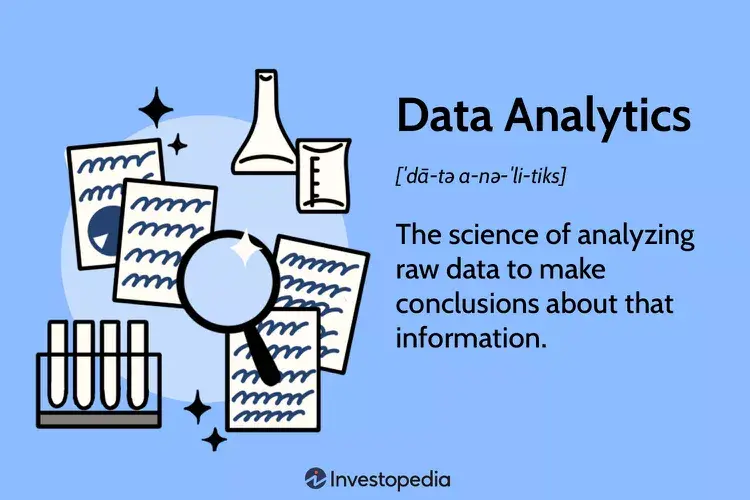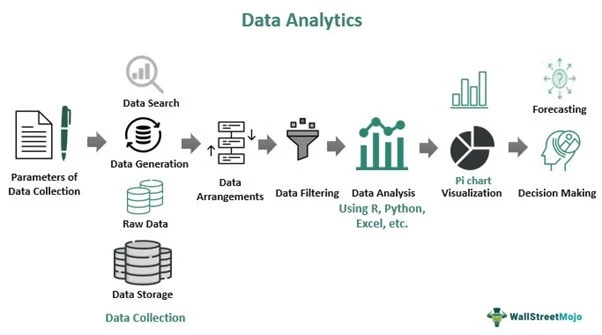How to Learn Data Analytics in 7 Simple Steps [Beginner’s Guide]
- -
- Time -

Learning data analytics may be exciting and intimidating, especially for newcomers. The capacity to analyze and draw conclusions from data is becoming increasingly important in today’s data-driven society, as shown in the many different businesses.
Whether you aim to improve your skill set or launch a career in data analytics, breaking down the learning process into digestible phases will help you feel more comfortable and confident about the attempt. You may progressively establish a strong foundation in data analytics and boost your self-confidence by adhering to an organized course.
We’ll walk you through seven easy steps in our beginner’s guide to help you get started and succeed in data analytics.
- Why is There a Need for Data Analysis?
- What is Data Analytics?
- Why is Data Analytics Important?
- Technical Skills Required for Data Analytics
- Role and Responsibility of Data Analysts
- 7 Simple Steps to Learning Data Analytics
- Challenges Related to Learning Data Analytics
- Career Opportunities Post Completing Data Analytics Course
- Final Thoughts
- FAQs
Why is There a Need for Data Analysis?
Before understanding how to learn data analytics, knowing why there is such a need is imperative. Data is an integral part of every organization. In 2020, the data produced worldwide was over 64 zettabytes. As per statistics, it is expected that by 2025, this number will go up to 180 zettabytes, and a single zettabyte is equivalent to a trillion gigabytes of data.
So, how to use this data? The best way is to derive valuable insights from it. Hence, you need tools like data analysis to help generate insights. Businesses can take advantage of these useful insights for various reasons. This data can help them understand their customer better, create strategic campaigns, and outrank their competition. All this is done by data analysts.
Hence, data analytics job opportunities are rising in today’s competitive world. Even though the opportunities are more, the competition to grab them is also high. Hence, there is a need to understand how to learn data analytics effectively.
What is Data Analytics?
Let’s first understand how data is created. It is a simple yet complex process. When you use an app, go to the supermarket, fill out a survey, or enter CAPTCHA for email login, you create a database for businesses. Only by these activities, a massive volume of data is collected daily. This data is further used by data analytics to develop insights for businesses.

Data analytics is a field where data analysis uses the data to extract valuable insights from the raw data. By doing this, companies can unlock their capacity for prediction, enabling them to make well-informed business decisions. Businesses can use data analytics to respond to the following queries: What has happened in the past? What is taking place right now? What may occur along the road?
Why is Data Analytics Important?

Data analytics plays a vital role in every business and organization. According to Forbes, data-driven organizations can acquire customers 23 times more than their competition. Here are some reasons why data analytics is necessary for any business:
- Data-driven decisions – Businesses can identify patterns and trends by analyzing data. Such analysis can help make better decisions related to their services, products, sales and marketing campaigns.
- Operation efficiency – Data analytics can help improve operational efficiency by identifying areas that need improvement. It can be things such as increasing productivity and reducing costs.
- New opportunities – Businesses can use data analytics to identify new opportunities, like new products or markets.
- Customer service – By better understanding the requirements and preferences of the consumer, data analytics contributes to improved customer service.
Technical Skills Required for Data Analytics
Since data analytics involves using different tools to evaluate data, there are some technical skills you must be aware of. These skills are easily learned through a recognized institute, such as CCSLA.
You can join CCSLA’s Data Analytics & Engineering bootcamp, which will have all these skills covered:
- R
- Python
- SQL
- Statistics
Role and Responsibility of Data Analysts
The job responsibilities of a data analyst may differ from company and sector. However, there are a few standard things, which are mentioned below:
- Use data visualization software to oversee the distribution of customer satisfaction surveys and report on the findings.
- Develop criteria, provide success indicators, oversee and carry out analytical initiatives, and assess outcomes in collaboration with business line owners.
- Keep an eye on procedures, systems, and processes to spot areas that might use improvement.
- Define concepts, assess needs, and work cooperatively and proactively with business units, stakeholders, technical teams, and support teams to ensure they are met.
- Convert significant queries into specific analytical assignments.
- Collect and arrange data from various sources to provide fresh information in response to client inquiries.
- Use analytical methods and resources to gather and provide fresh insights to customers through interactive dashboards and reports.
- Transform intricate ideas and information into visual aids.
- Work with other members, such as the team’s data scientists, to identify the optimal product solutions.
- Create, assemble, verify, and update backend code.
- Create data processes, specify data quality requirements, and implement data quality procedures.
- Assume responsibility for the codebase and provide changes and refactoring ideas.
- Create tools and models for data validation to ensure the captured data is accurate.
- Collaborate as a group to assess and examine essential facts that may influence future company plans.
7 Simple Steps to Learning Data Analytics
If you want to know how to learn data analytics, here are seven easy steps.
#1. Get a Formal Education
Formal education is necessary for any course or degree. For you to learn data analytics, it is a great option to get a formal education in a closely related field. For instance, you can get a bachelor’s degree in mathematics, statistics, economics, computer science, information technology, or engineering.
Although a bachelor’s degree is often enough for this position, some companies even look for a master’s degree. You can still become a data analyst if you do not have a degree in one of these fields. You should focus on statistics or mathematics and have a strong hold on concepts such as linear algebra, probability, intentional statistics, and calculus. These are must skills for data analysts.
#2. Work on Your Domain Skills
Data analytics is a growing field with a lot of competition. Therefore, you must be an expert in technical skills to stand out from the competition. You should begin with a structured program from a recognized place that covers all the fundamentals and introduces you to data analytics tools.
You should learn data structures and their types, data processing and preparation, data analysis methods, data narrative and visualization, and how to answer questions using data. If you have already learned these, check your skills and identify where you need improvement to be an expert.
#3. Work on Projects with Actual Data
Employers often look for people with some experience and knowledge. If you are also looking for an entry-level job, they will expect you to have some experience with actual data. Working on projects is an excellent way of showcasing your skills. You can take open-source projects from websites such as GitHub.
You can also work with different people or take on a team project. Doing so will help you learn and gain experience while also preparing you with teamwork skills. You should focus on different projects, such as data cleaning, storytelling, explanatory, end-to-end, data visualization, etc.
#4. Build Your Portfolio
Once you have worked on projects, the next step is to build your portfolio to show to future employers. Your portfolio is what will tell the recruiters and employers about your skills. The best way is to host your portfolio online, as it is easy to update. In that portfolio, include different projects to showcase your other skills.
Include projects that you completed alone and with a team. Also, remember to include projects you may have completed using different programming languages or analysis methods while clearly mentioning your findings.
#5. Practice Presenting Your Findings
Concentrating on the technical elements of data analysis may be simple, but pay attention to your ability to communicate. Presenting your results to decision-makers and other corporate stakeholders is crucial to working as a data analyst. Your organization may make data-driven decisions when you can use the facts to convey a story.
As you complete activities for your portfolio, get comfortable presenting your findings. Think about the point you want to make and the pictures you want to support it with. Make a point of speaking clearly and maintaining eye contact. You can rehearse in front of the mirror or with your peers. Try recording your presentation so you can watch it again and see where you might improve.
#6. Find an Entry-Level Job
Experience is a must to succeed in any career, including data analytics. You can gain this experience by taking an entry-level job. You can find this job in many different industries and sectors as data today is used across.
You can look for an entry-level position at hedge funds, investment banks, private firms, healthcare, retail, and marketing sectors. Many positions are also open in insurance, manufacturing, and tech-related companies.
#7. Gain Certifications
Data analytics is an ever-growing field; to stay updated, one must continue to upskill oneself. There are many data analytics courses available, both online and offline that you can choose from. These courses can help you prepare for a career in data analytics and equip you to turn data into valuable insights.
Challenges Related to Learning Data Analytics
Every skill or course has its own set of challenges and there are some for data analytics as well. It can be a complex field for non-technical people or someone who needs experience in programming languages.
Here are some challenges that you must be aware of:
- The first step requires you to search for data to use. It is not any data but the data that can offer valuable insights to the organization. There are many sources for this data thus making it more difficult for data analysts to identify the source. Hence, you must be aware of data warehouses, where data from all sources can be consolidated in one place.
- Another common challenge is understanding the data which has already been accessed. This procedure frequently calls for tracking information, such as each column definition in a data warehouse’s tables, to document data assets. Automated analytic features, one of the most recent answers to this obstacle, may significantly speed up this procedure without compromising accuracy.
- Data analysts must spend a lot of effort cleaning the data once it is available. Although some people consider this step of the analytics process to be the most unpleasant, it is essential as it ensures that the models used are constructed with clean, high-quality data. Pre-processing could be sped up with the usage of AI and machine learning in advanced analytics.
Career Opportunities Post Completing Data Analytics Course
Here are a couple of in-demand career opportunities to try after finishing your course:
- Data Scientist – To use data visualization to get the right conclusions, data scientists collect and analyze this data. The average salary of a data scientist is $124216 an annum.
- Data Engineer – A data engineer works with rather large data sets and often helps with data cleaning and profiling to prepare the data for use by data scientists. The average salary of a data engineer is $1,44,602 an annum.
Final Thoughts
In conclusion, if novices approach the task carefully and with determination, understanding data analytics is a goal they can achieve. You may progressively improve your abilities and self-assurance in managing data by adhering to the seven easy procedures described in this article.
Always practice frequently, look for more possibilities for practical experience and resources, and maintain your curiosity and adaptability when faced with new obstacles.
You may become an expert in the subject of data analytics and be prepared to face real-world issues and make significant contributions in this ever-evolving profession if you are persistent and dedicated to your studies.
For this, you can enroll in the Data Analytics & Engineering bootcamp by CCSLA, which can help you achieve your dream of starting a career in data analytics in as little as 12 weeks.
FAQs
Data analytics involves examining raw data with the purpose of drawing conclusions about that information. It is used in many industries to allow companies and organizations to make better business decisions and in the sciences to verify or disprove existing models or theories.
Learning data analytics can open up opportunities in numerous fields such as finance, healthcare, technology, marketing, and more. It helps professionals to make data-driven decisions, optimize processes, predict trends, and understand consumer behaviors, enhancing business performance.
Basic skills include a good grasp of mathematics, particularly statistics, an understanding of analytical problem-solving, and proficiency with computers. Familiarity with spreadsheets and an interest in interpreting data sets are also beneficial starting points.
Python and R are the most commonly used programming languages in data analytics. Python is favored for its simplicity and readability, while R is designed specifically for data visualization and statistical computing.
There are many high-quality resources available, including online courses from platforms like Coursera, edX, and Udacity that offer programs in data analytics. Books, webinars, and hands-on workshops can also be beneficial. Key resources to start with might include “Data Science from Scratch” by Joel Grus and online courses like Google’s Data Analytics Professional Certificate.
The time it takes can vary widely depending on your background and the amount of time you can dedicate to learning. Typically, it could take anywhere from a few months to a year to gain proficiency in the fundamentals of data analytics through self-study or structured courses.
Practical applications include improving business efficiencies, conducting market and consumer analysis, healthcare management, risk management, improving sporting performances, and much more. Data analytics allows organizations to leverage their data to extract useful insights that drive strategic decisions.
Many individuals successfully learn data analytics on their own using online resources and books. However, formal classes can provide structured learning, practical assignments, and feedback from experienced instructors, which might be beneficial for complete beginners.
Beginners might struggle with the mathematical concepts involved, the complexity of learning programming languages, and the overwhelming amount of tools and technologies available. It’s important to start with the basics and gradually build up your skills.
Staying updated can be achieved by following relevant blogs, joining forums, participating in webinars, and attending industry conferences. Subscribing to newsletters from prominent data analytics platforms and continuing education through advanced courses can also help.






